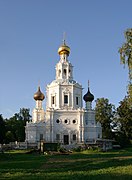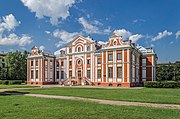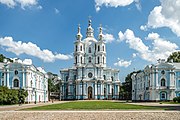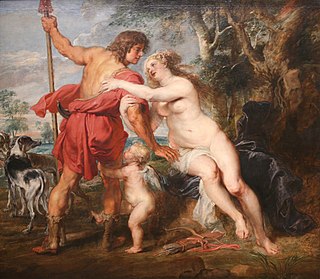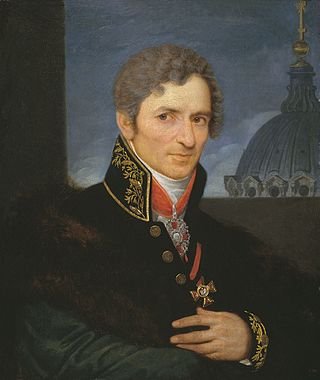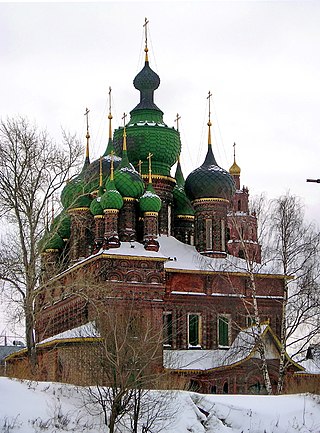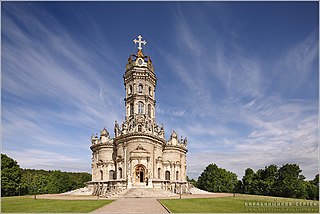General definitions
Baroque architecture is characterised by the opening of volumes into surrounding space, dynamism, expression of forms, exaggeration of scales, majestic ensembles, and huge building sizes. It features powerful proportions, contrasts of closed and open spaces, twisted columns, and dramatic effects, including light coming from the dome above. Baroque architecture also includes illusions of statues coming to life, an abundance of colour and gilding, and quadratura of paintings with trompe-l'œil effects. In Russia, Baroque art had a number of special features. [1]
In Russia, the Renaissance did not fully develop in the same way as it did in Western Europe, particularly in Italy, due to specific socio-economic conditions. As a result, the personalisation of creativity necessary for the development of art as a history of artistic styles was not achieved until the 18th century. For comparison, during the Renaissance in Italy, the works of Leonardo da Vinci, Raphael, and Michelangelo became major artistic trends that later influenced the development of all Western European classical art. In contrast, during the era of the 'Russian Renaissance' in Russia, the outstanding works of Andrei Rublev and Dionisius had more of a general spiritual significance. The change in world outlook that occurred in Europe during the Italian Renaissance was slower to take hold in Russia, happening throughout the 17th century. As a result, the enlightenment functions of the Renaissance were reflected in the art of the so-called 'Russian Baroque' of the 17th century. Its main significance lies not in being an integral artistic style, but rather as a humanistic, enlightenment ideological movement that introduced Russian culture to the achievements of Western European civilization. [1]
The second crucial difference between the development of Russian art and Western European art is that Russia's distance from the classical art centres of Athens, Rome, Florence, and Paris caused a delay and subsequent 'splicing' of historical artistic styles. These styles were consistently born and developed in the metropolises one after another. The chronology and typology of artistic styles in Russia during the 18th and 19th centuries differ significantly from those in Western Europe. [2]
Natalia Kovalenskaya was the first historian of Russian art of the 18th century to identify the unique 'splicing' of artistic styles in Russia. She wrote that after Peter the Great's reforms in the early 18th century, "many stages, consistently undergone by other European nations, in Russia often appeared as if spliced, compacted...there were sometimes unexpected combinations of very dissimilar phenomena". [3]
In the 1940s Boris Viipper further specified this thesis in his articles: "It is more correct, apparently, to imagine the picture of the development of the artistic outlook in Russia in the sense that, catching up with Europe at an ever more accelerating pace, Russian art simultaneously solved the problems of previous stages of development, and sometimes, on the contrary, unexpectedly leaped ahead of Europe and went out of the framework of a seemingly natural development, thus combining advanced features with backward elements, with traditions deeply conservative during the course of one evolution stage". [4]
Something similar happened in England, where the historical and territorial separation from continental Europe, combined with the unique English psychology, gave rise to a distinctive 'English style'. This style has remained largely unchanged over the centuries and unites local variants that are slightly different from each other, but very different from European, such as English classicism, baroque, and rococo. [1] In Western Europe, the Baroque style, particularly in architecture, was developed by reinterpreting the established classicist forms of architecture and painting that had already been established in Italy at the start of the 16th century. In Russia, a different sequence of artistic styles took place: first, a particular 'Russian Baroque' developed in the late 17th and first half of the 18th century, followed by Classicism in the second half of the 18th and early 19th centuries. In Western Europe, the second half of the 18th century is known as neoclassicism, which was the second or third wave of the classicist movement. Russia, on the other hand, was experiencing this stage for the first time. Therefore, many researchers believe that as much as Western European influences on Russian culture strengthened in the 17th century, they should not be considered the cause of a new style. The increase in influence was more likely a consequence of the peculiarities of pre-Renaissance national development. [1]
During the first half of the 18th century, [5] Baroque art flourished in Russia, reflecting the growth and consolidation of the absolute monarchy. The Russian mature Baroque, especially in architecture, was distinguished from Western European Baroque by its structural clarity and simplicity of planning solutions, as well as the close connection between the structural basis and decorative elements. Another notable characteristic of Russian Baroque is its prominent use of colour, bold colour contrasts, and chiaroscuro, including gilding. [6]




